

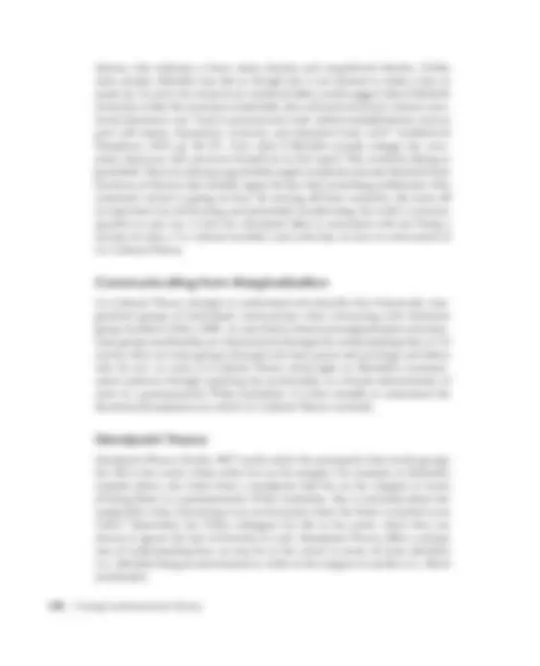
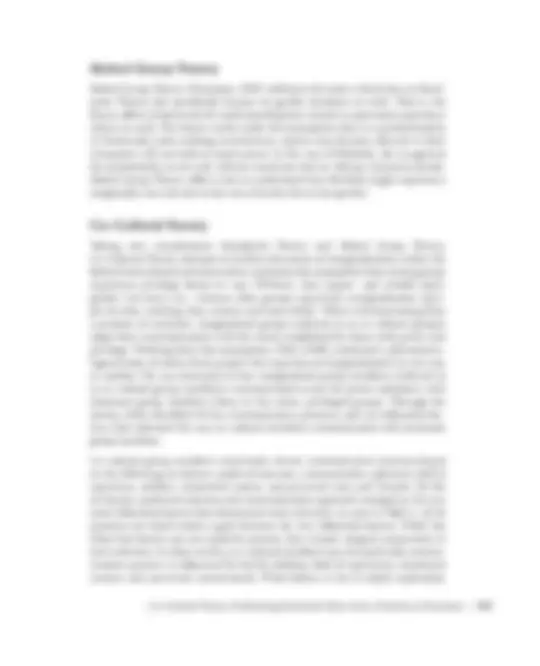
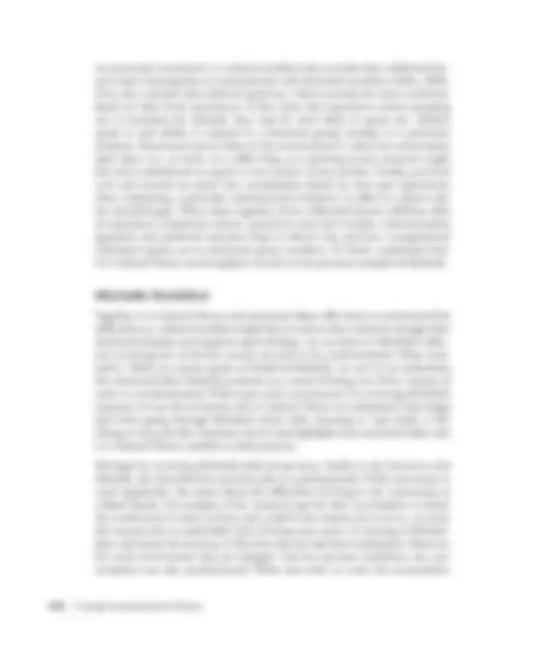
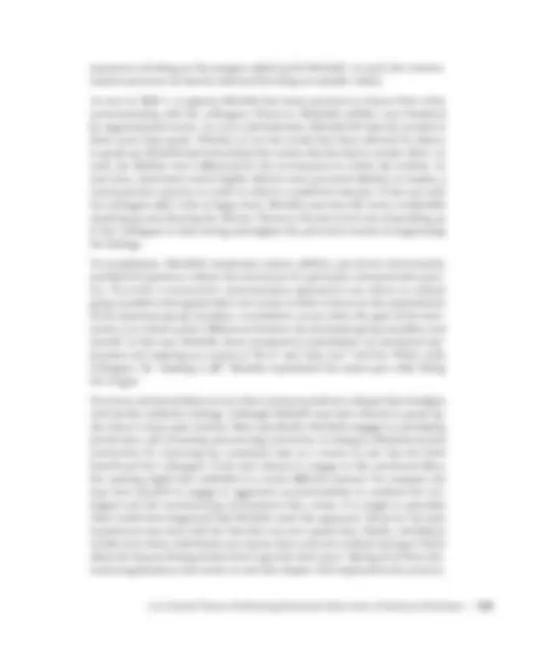
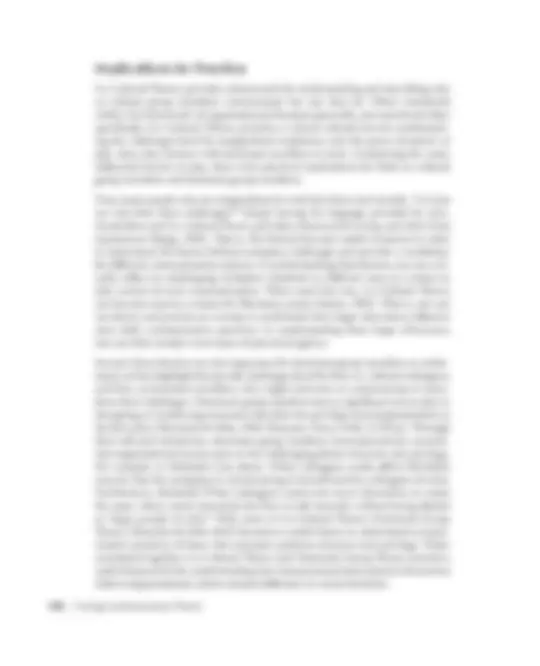
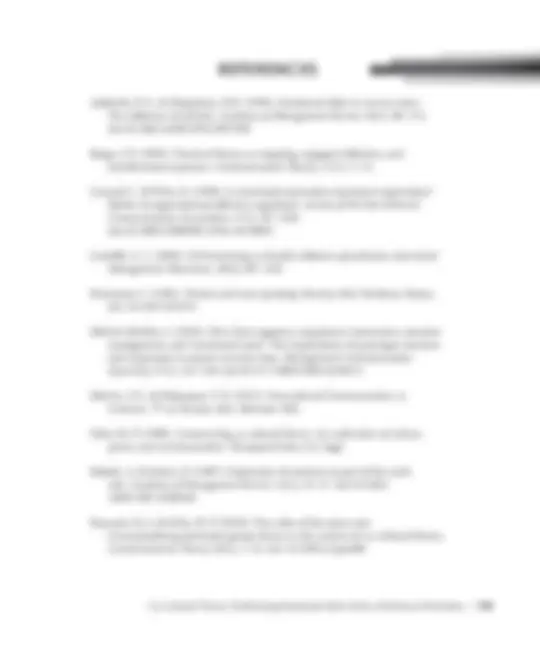
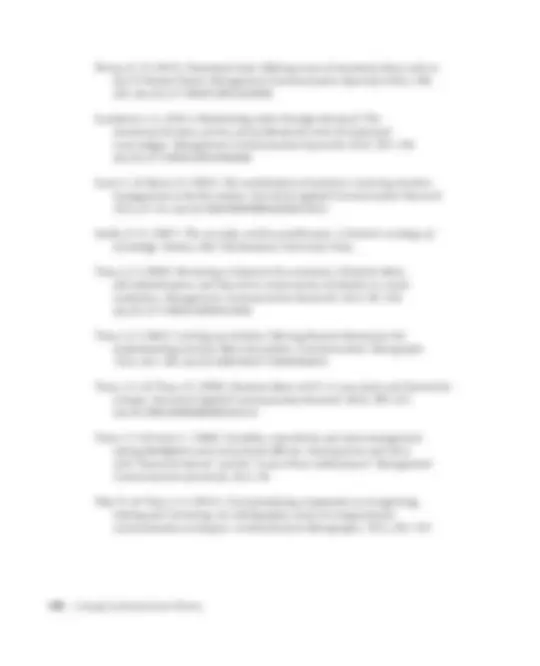


Study with the several resources on Docsity

Earn points by helping other students or get them with a premium plan


Prepare for your exams
Study with the several resources on Docsity

Earn points to download
Earn points by helping other students or get them with a premium plan
Community
Ask the community for help and clear up your study doubts
Discover the best universities in your country according to Docsity users
Free resources
Download our free guides on studying techniques, anxiety management strategies, and thesis advice from Docsity tutors
The concept of Co-Cultural Theory and its application to emotional labor, focusing on the experiences of historically marginalized employees in the workplace. The authors use real-life examples to illustrate how Co-Cultural Theory sheds light on communication patterns of marginalized individuals, particularly women of color, in predominantly White institutions. The document also discusses Muted Group Theory and its relationship to Co-Cultural Theory, and identifies key communicative practices and influential factors that inform the way co-cultural members communicate with dominant group members.
What you will learn
Typology: Study notes
1 / 14

This page cannot be seen from the preview
Don't miss anything!









Co-Cultural Theory: Performing Emotional Labor from a Position of Exclusion | 117
Robert Razzante, M.A. | Sarah Tracy, Ph.D.
Earlier this week we met with the board of trustees, and I was the only African Amer- ican woman in the room. There was an Ethiopian–African man in the room who was of color, but I was the only African American female. In the room was a White male here and another White male there. Basically, there were three little brown specks in a room of like 30. It is one of those things that I don’t let bother me as much. Sometimes you feel like (audible sigh), but you just shake it off.
–Michelle
The quote above comes from an interview with Michelle, an academic adminis- trator in a predominately White, private institution in Philadelphia. Michelle is a Black female who works with mostly White men. As demonstrated by her quote, Michelle sometimes suppresses her upset emotions at work due to being one of the only women of color in her work meetings and, instead, works to project a positive, unaffected demeanor. Co-Cultural Theory (Orbe, 1998) becomes a use- ful lens when seeking to understand the experiences of historically marginalized employees in a workplace. As demonstrated by Michelle’s quote above, being a Black female in a predominantly White, male workplace may cause lots of dis- tress. To deal with such distress, Michelle, and other co-cultural group members, may find themselves practicing emotional labor. In this chapter, we explore emo- tional labor literature as a foreground for describing ways that historically margin- alized groups manage their communication while at work. More specifically, we explore how marginalized people manage their emotions in workplaces that seek to intentionally or unintentionally create division between those who have power and those who do not. In this chapter we use Co-Cultural Theory and emotional labor to explore how and why marginalized people communicate in similar ways as Michelle in the excerpt above.
118 | Casing Communication Theory
Anyone who has ever pretended to adore a gift that they did not want, or who has suppressed their giggles when sternly reprimanding a pet for bad behavior, has engaged in emotion management. The experience of performing or suppressing emotions as part of a paid job for organizational benefit is called emotional labor. Sociologist Arlie Hochschild first coined the term “emotional labor” through her research on the ways that airline flight attendants were expected to put on a happy face and how bill collectors were taught to be angry and intimidating with delin- quent clients (1983). Specifically, emotional labor refers to “the management of feeling to create a publicly observable facial and bodily display” for commerce (Hochschild, 1983, p. 7). It is easy to see how this type of work is integral to many different types of jobs, including those in service, teaching, and human interac- tion. Firefighters act tough (Scott & Meyers, 2005), cruise ship employees smile (Tracy, 2000), nurses show compassion (Way & Tracy, 2012), judges suppress their amusement (Scarduzio, 2011), TSA agents absorb passenger irritation (Malvini Redden, 2013), 911 call-takers calm frightened citizens (Tracy & Tracy, 1998), and border patrol agents navigate the tensions of upholding the law while being kind to suffering border crossers (Rivera, 2015). Although some jobs require very specific types of emotional labor, typical emotional labor expectations mark almost all organizational settings, such as the norms that subordinates act respect- ful toward bosses and that frontline employees absorb irritation from customers without complaint.
Employees engage in emotional labor through suppressing, amplifying, and/or masking their emotions, or a combination thereof (Tracy, 2005). As Michelle explains in the excerpt at the beginning of this chapter, internally, she feels upset. However, she suppresses her distress, and does not voice the difficulty and sadness of feeling like a token Black woman in the sea of White faces. She, instead, “shakes it off,” presumably through various bodily and facial displays. She may mask her distress by smiling at the other employees or by pretending to be engrossed in the meeting agenda.
Employees manipulate their emotions in two main ways. Surface acting is when employees transform (or fake) their outward emotional displays to fit the organi- zational expectation, while not authentically feeling what the organization expects (Hochschild, 1983). In this particular case, Michelle is surface acting because she is still clearly upset, but she is pretending not to be. However, faking emotion can go one step further to deep acting, which is when employees convince them- selves to deeply and internally feel the expected organizational emotion. In such cases, employees no longer need to “fake” the expected emotional display because they have changed their real feelings, and the emotional expression follows suit
120 | Casing Communication Theory
distress, this indicates a lower status identity and unpreferred identity. Unlike some people, Michelle may feel as though she is not allowed to make a fuss or speak up. As such, the research on emotional labor would suggest that if Michelle continues to fake her emotions in bad faith, this will lead to burnout. Indeed, emo- tional dissonance can “lead to personal and work-related maladjustment, such as poor self-esteem, depression, cynicism, and alienation from work” (Ashforth & Humphrey, 1993, pp. 96–97). And, what if Michelle actually changes her view- point, deep acts, and convinces herself not to feel upset? This would be faking in good faith. However, faking in good faith might completely alienate Michelle from emotions of distress that usefully signal the fact that something problematic (like systematic racism) is going on here. By turning off these emotions, she turns off an important way of knowing, and potentially transforming, the world. A primary question to ask, too, is how her emotional labor is associated with her being a woman of color, a “co-cultural member,” and, with that, we turn to a discussion of Co-Cultural Theory.
Co-Cultural Theory attempts to understand and describe how historically mar- ginalized groups of individuals communicate when interacting with dominant group members (Orbe, 1998). As seen below, historical marginalization and dom- inant group membership are characterized through the understanding that, in US society, there are some groups of people who have power and privilege, and others who do not. As such, Co-Cultural Theory sheds light on Michelle’s communi- cation patterns through exploring her positionality as a female administrator of color in a predominantly White institution. It is first valuable to understand the theoretical foundations on which Co-Cultural Theory was built.
Standpoint Theory (Smith, 1987) works under the assumption that certain groups live life in the center, whiles other live on the margins. For example, in Michelle’s example above, she works from a standpoint that lies on the margins in terms of being Black in a predominantly White institution. She is reminded about her marginality when interacting in an environment where her body is marked as an “other.” Meanwhile, her White colleagues live life in the center, where they can choose to ignore the lack of diversity at work. Standpoint Theory offers a unique way of understanding how we may be in the center in terms of some identities (i.e., Michelle being an administrator), while on the margins in another (i.e., Black and female).
Co-Cultural Theory: Performing Emotional Labor from a Position of Exclusion | 121
Muted Group Theory (Kramarae, 1981) embraces the same critical lens as Stand- point Theory, but specifically focuses on gender dynamics at work. That is, the theory offers a framework for understanding how women in particular experience silence at work. The theory works under the assumption that, in a predominantly or historically male working environment, women may become silenced or their viewpoints will not hold as much power. In the case of Michelle, she recognized her positionality as not only African American, but an African American female. Muted Group Theory offers a lens to understand how Michelle might experience marginality not only due to her race, but also due to her gender.
Taking into consideration Standpoint Theory and Muted Group Theory, Co-Cultural Theory attempts to localize discourses of marginalization within the field of intercultural communication. maintains the assumption that certain groups experience privilege based on race (Whites), class (upper- and middle-class), gender (cis-men), etc., whereas other groups experience marginalization (peo- ple of color, working-class, women and trans-folks). When communicating from a position of exclusion, marginalized groups (referred to as co-cultural groups) adapt their communication to fit the norms established by those with power and privilege. Working from this assumption, Orbe (1998) conducted a phenomeno- logical study of stories from people who experienced marginalization in one way or another. He was interested in how marginalized group members (referred to as co-cultural group members) communicated across the power imbalance with dominant group members (those in the center, privileged group). Through the stories, Orbe identified 26 key communicative practices, and six influential fac- tors, that informed the way co-cultural members communicated with dominant group members.
Co-cultural group members consciously choose communicative practices based on the following six factors: preferred outcome, communication approach, field of experience, abilities, situational context, and perceived costs and rewards. Of the six factors, preferred outcome and communication approach emerged as the two most influential factors that determined one’s selection. As seen in Table 1, all 26 practices are listed within a grid between the two influential factors. While the other four factors are not explicitly present, they remain integral components to one’s selection. In other words, a co-cultural member’s use of a particular commu- nication practice is influenced by his/her abilities, field of experience, situational context, and perceived costs/rewards. What follows is the in-depth exploration
Co-Cultural Theory: Performing Emotional Labor from a Position of Exclusion | 123
Contrary to assimilation lies separation. Instead of reducing power distances, separation seeks to uphold such distance (i.e., avoiding, embracing stereotypes, attacking). Within the tension between assimilation and separation lies accommo- dation. Accommodation exhibits the desire to negotiate power distances between co-cultural group members and dominant group members (i.e., dispelling stereo- types, communicating self, confronting).
As explored through Co-Cultural Theory, depending on one’s goals, a marginal- ized group member in a working environment may enact one of the practices listed under those headings. That is, using assimilation, accommodation, or separation becomes a strategic move among co-cultural group members seeking to navigate structures that privilege dominant group members and suppress co-cultural mem- bers. Depending on the context, one’s abilities, their perceived costs and rewards, field of experience, and situational context, a co-cultural group member may choose one approach over the other. The effects of a particular approach depend on the situational context in which the communication approach occurs. There is no right or wrong way for a co-cultural group member to act. Rather, like all communication, decisions become contextually based. In addition to envisioning a preferred outcome, co-cultural group members may employ specific approaches to achieve their desired goal. What follows is an exploration of three communica- tion approaches co-cultural group members might employ as a means to achieve their preferred outcome. When in a working environment, it becomes necessary to develop such communication skills to be able to advocate for oneself. As such, Co-Cultural Theory generally, and communication approaches specifically, provide a lens to understand how a co-cultural group member might be able to communi- cate to achieve his/her intended goal.
Employees can achieve their preferred outcome via a variety of communication approaches, which can range from nonassertive to aggressive. A nonassertive communication approach transpires when a co-cultural group member elevates the needs of the dominant group member before his/her own (Orbe, 1998). Con- trarily, an aggressive communication approach occurs where co-cultural group members emphasize their own needs/desires while disregarding the needs/desires of dominant group member (Orbe, 1998). In between nonassertive and aggressive communication lies an assertive communication approach. An assertive approach manifests when the needs/desires of both co-cultural and dominant group mem- bers are considered when attempting to achieve a preferred outcome. Assertive communication approaches demonstrate one’s ability to think about both him/ herself in relation to another person. Such an approach demonstrates self-aware- ness, and awareness for others, in an interaction.
124 | Casing Communication Theory
As previously mentioned, co-cultural members also consider four additional fac- tors when choosing how to communicate with dominant members (Orbe, 1998). First, they consider their field of experience, which accounts for one’s worldview based on their lived experiences. If they have had experiences where speaking out is rewarded, for example, they may be more likely to speak out. Abilities speak to one’s ability to respond to a dominant group member in a particular situation. Situational context refers to the environment in which the conversation takes place (i.e., at work, in a coffee shop, at a sporting event); someone might feel more emboldened to speak in one context versus another. Finally, perceived costs and rewards are taken into consideration based on one’s past experiences when employing a particular communicative behavior in effort to achieve his/ her intended goal. When taken together, all six influential factors (abilities, field of experience, situational context, perceived costs and rewards, communication approach, and preferred outcome) help to inform why and how a marginalized individual speaks out to dominant group members. To better understand how Co-Cultural Theory can be applied, we turn to the previous example of Michelle.
Together, Co-Cultural Theory and emotional labor offer lenses to understand the difficulties co-cultural members might face at work as they routinely manage their emotional displays and suppress upset feelings. Let us return to Michelle’s reflec- tion on being one of the few women of color in her predominantly White insti- tution. While we cannot speak on behalf of Michelle, we can try to understand the emotional labor Michelle performs as a result of being one of few women of color in a predominantly White male work-environment. In reviewing Michelle’s response, we use the six factors of Co-Cultural Theory to understand what might have been going through Michelle’s mind while choosing to “just shake it off.” Doing so may provide a heuristic device that highlights how emotional labor and Co-Cultural Theory manifest in daily practice.
We begin by reviewing Michelle’s field of experience. Earlier in the interview with Michelle, she described her previous job at a predominantly White university in rural Appalachia. She spoke about the difficulties of living in the community as a Black female. For example, if she wanted to get her hair cut, braided, or styled, she would need to travel an hour and a half to the nearest city to do so. As such, the resources for a comfortable style of living were scarce. In moving to Philadel- phia, she found the increase in diversity that she had been looking for. However, her work environment had not changed. Like her previous institution, her new workplace was also predominantly White and male. As such, the accumulative
126 | Casing Communication Theory
Co-Cultural Theory provides a framework for understanding and describing why co-cultural group members communicate the way they do. When considered within the framework of organizational literature generally, and emotional labor specifically, Co-Cultural Theory provides a critical-cultural lens for understand- ing the challenges faced by marginalized employees, and the power dynamics at play when they interact with dominant members at work. Considering the many influential factors at play, there exist practical implications for both co-cultural group members and dominant group members.
First, many people who are marginalized at work feel alone and wonder, “is it just me who feels these challenges?” Simply having the language provided by emo- tional labor and Co-Cultural Theory provides a framework to map onto their lived experiences (Barge, 2001). That is, the theories become useful resources in order to understand the factors behind workplace challenges and provide a vocabulary for different communication options. In understanding these factors, one can crit- ically reflect on challenging workplace situations in different ways as a means to take control of one’s communication. When used this way, Co-Cultural Theory can become used as a means for liberatory praxis (hooks, 1994). That is, one can use theory and practice as a means to understand how larger discourses influence one’s daily communicative practices. In understanding these larger discourses, one can then reclaim a lost sense of perceived agency.
Second, these theories are also important for dominant group members to under- stand, as they highlight the specific challenges faced by their co-cultural colleagues, and how, as dominant members, they might intervene or communicate to trans- form these challenges. Dominant group members have a significant role to play in disrupting or reinforcing structures that allow for privilege and marginalization in the first place (Razzante & Orbe, 2018; Razzante, Tracy, Orbe, In Press). Through their talk and interaction, dominant group members communicatively coconsti- tute organizational norms open to the challenging abuses of power and privilege. For example, in Michelle’s case above, White colleagues could affirm Michelle’s concern that the workplace is unwelcoming to herself and her colleagues of color. Furthermore, Michelle’s White colleagues could even move themselves to create the space where racial minorities feel free to talk honestly without being labeled as “angry people of color.” With roots in Co-Cultural Theory, Dominant Group Theory (Razzante & Orbe 2018) becomes a useful theory to understand commu- nicative practices of those who maintain positions of power and privilege. When considered together, Co-Cultural Theory and Dominant Group Theory provide a useful framework for understanding how interpersonal/intercultural interactions inform organizational culture around difference in social identities.
Co-Cultural Theory: Performing Emotional Labor from a Position of Exclusion | 127
Third, this analysis suggests that employees consider the variety of intersectional ways that employees might feel marginalized or the factors that contribute to the mal-effects of performing emotional labor. That is, rather than essentializing some- one as only a co-cultural group member or a dominant group member, we recom- mend considering how a single individual may be both a co-cultural member and a dominant group member. For example, although Michelle is a co-cultural group member in terms of race and gender, she is a dominant group member in terms of class, educational level, and ability. As seen in Dominant Group Theory, most dominant group members, especially if they live long enough to be considered “old” (itself a marginalized identity category), will eventually become a co-cultural group member (Razzante & Orbe, 2018). In taking an intersectional approach, readers can develop a more nuanced and holistic understanding of privilege and marginalization as it manifests in the workplace.
Finally, while this chapter provides a conceptual overview of Co-Cultural Theory and emotional labor, we recommend using this knowledge to transform one’s life as lived. That is, we encourage readers to take this knowledge to engage in critical self-reflexivity to challenge one’s own assumptions about him/herself and others (Cunliffe, 2004). Questions to ask oneself include the following:
Indeed, critically questioning the factors behind one’s own, and others’, com- munication can lead to more competent and effective dialogue and interaction at work. Moreover, readers are left to imagine and create workplaces that thrive through difference by embodying Co-Cultural Theory, Dominant Group Theory, and emotional labor literature through their everyday interactions. When this happens, Michelle and others like her may be released from an unjust burden of emotional labor.
Co-Cultural Theory: Performing Emotional Labor from a Position of Exclusion | 129
REFERENCES
Ashforth, B. E., & Humphrey, R.H. (1993). Emotional labor in service roles: The influence of identity. Academy of Management Review 18(1), 88–115. doi:10.5465/AMR.1993.
Barge, J. K. (2001). Practical theory as mapping, engaged reflection, and transformative practice. Communication Theory, 11(1), 5–13.
Conrad, C. & Witte, K. (1994). Is emotional expression repression oppression? Myths of organizational affective regulation. Annals of the International Communication Association 17(1), 417–428. doi:10.1080/23808985.1994.
Cunliffe, A. L. (2004). On becoming a critically reflexive practitioner. Journal of Management Education, 28(4), 407–426.
Kramarae, C. (1981). Women and men speaking. Rowley, MA: Newbury House. doi: 10.2307/
Malvini Redden, S. (2013). How lines organize compulsory interaction, emotion management, and “emotional taxes”: The implications of passenger emotion and expression in airport security lines. Management Communication Quarterly 27(1), 121–149. doi:10.1177/
Martin, J. N., & Nakayama, T. K. (2017). Intercultural Communication in Contexts. 7th ed. Boston, MA: McGraw-Hill.
Orbe, M. P. (1998). Constructing co-cultural theory: An explication of culture, power, and communication. Thousand Oaks, CA: Sage.
Rafaeli, A, & Sutton, R. (1987). Expression of emotion as part of the work role. Academy of Management Review 12(1), 23–37. doi:10.5465/ AMR.1987.
Razzante, R. J., & Orbe, M. P. (2018). Two sides of the same coin. Conceptualizing dominant group theory in the context of co-cultural theory. Communication Theory 28(1), 1–22. doi: 10.1093/ct/qtx
130 | Casing Communication Theory
Rivera, K. D. (2015). Emotional taint: Making sense of emotional dirty work at the US Border Patrol. Management Communication Quarterly 29(2), 198–
Scarduzio, J. A. (2011). Maintaining order through deviance? The emotional deviance, power, and professional work of municipal court judges. Management Communication Quarterly 25(2), 283–310. doi:10.1177/
Scott, C. & Myers, K. (2005). The socialization of emotion: Learning emotion management at the fire station. Journal of Applied Communication Research 33 (1), 67–92. doi:10.1080/
Smith, D. E. (1987). The everyday world as problematic: A feminist sociology of knowledge. Boston, MA: Northeastern University Press.
Tracy, S. J. (2000). Becoming a character for commerce: Emotion labor, self-subordination, and discursive construction of identity in a total institution. Management Communication Quarterly 14(1), 90–128. doi:10.1177/
Tracy, S. J. (2005). Locking up emotion: Moving beyond dissonance for understanding emotion labor discomfort. Communication Monographs 72(3), 261–283. doi:10.1080/
Tracy, S. J., & Tracy, K. (1998). Emotion labor at 911: A case study and theoretical critique. Journal of Applied Communication Research 26(4), 390–411. doi:10.1080/
Tracy, S. J. & Scott, C. (2006). Sexuality, masculinity and taint management among firefighters and correctional officers: Getting down and dirty with “America’s heroes” and the “scum of law enforcement.” Management Communication Quarterly, 20, 6–38.
Way, D., & Tracy, S. J. (2012). Conceptualizing compassion as recognizing, relating and (re)acting: An ethnographic study of compassionate communication at hospice. Communication Monographs, 79(1), 292–315.